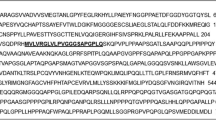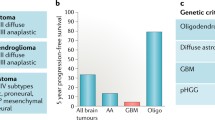Summary
To examine the relationship between the malignant behavior of rat glioma cells and expression of the differentiation antigen glial fibrillary acidic protein (GF), we assayed the tumorigenicity and metastatic ability of P635 and its GF + or GF − clones. We injected P635 (GF+) and clone 45 (GF−) cells intramuscularly in nude mice. Both lines formed local tumors which metastasized to lungs with equal efficiency. We then injected these lines intravenously in nude mice. Both produced experimental metastases in lungs and other organs with equal efficiency. Finally we injected P635 and several GF+ and GF− clones into the chorioallantoic membrane veins of naturally immune-deficient chick embryos and measured cell growth in embryonic liver. We again found that all clones survived and grew equally well. P635 cells are capable of extracranial growth and metastasis, two important features of the malignant phenotype. We conclude that GF in P635 is a neutral marker with respect to tumorigenicity and metastatic ability.
Similar content being viewed by others
References
Alvord EC Jr: Why do gliomas not metastasize? Arch Neurol 33: 73–75, 1976
Kageyama N, Zimmerman HM: Glioma metastases — an experimental study. J Neuropath Exp Neurol 20: 303–304, 1961
Maat B, van Zwieten MJ, van Bekkum DW, Vecht C: Transplantability and metastatic potential of chemically induced rat brain tumors. Biomedicine 31: 228–230, 1979
Macdonald DR, O'Brien RA, Gilbert JJ, Cairncross JG: Metastatic anaplastic oligodendroglioma. Neurology 39: 1593–1596, 1989
Juurlink BHJ, Federoff S, Hall C, Nathaniel EJH: Astrocyte cell lineage. I: Astrocyte progenitor cells in mouse neopallium. J Comp Neurol 200: 375–391, 1981
Russell DS, Rubinstein LJ: Pathology of tumors of the nervous system. Baltimore: Williams and Wilkins, 83–350, 1989
Lee YS, Bigner SH, Eng LF, Molnar P, Kuruvilla A, Groothuis DR, Bigner DD: A glial fibrillary acidic protein-expressing and tumorigenic cell line derived from an avian sarcoma virus-induced rat astrocytoma. J Neuropath and Exp Neurol 45: 704–720, 1986
Wang E, Cairncross JG, Yung WKA, Garber A, Liem RKH: An intermediate filament-associated protein, p50, recognized by monoclonal antibodies. J Cell Biol 97: 1507–1514, 1983
Sharkey FE, Fogh J: Considerations in the use of nude mice for cancer research. Cancer Metastasis Reviews 3: 341–360, 1984
Fidler IJ: Rationale and methods for the use of nude mice to study the biology and therapy of human cancer metastasis. Cancer Metastasis Reviews 5: 29–49, 1986
Chambers AF, Shafir R, Ling V: A model system for studying metastasis using the embryonic chick. Cancer Research 42: 4018–4025, 1982
Chambers AF, Tuck AB: Oncogene transformation and the metastatic phenotype. Anticancer Research 8: 861–872, 1988
Chambers AF, Denhardt GH, Wilson SM: Ras-transformed NIH 3T3 cell lines, selected for metastatic ability in chick embryos, have increased proportions of p21-expressing cells and are metastatic in nude mice. Invasion and Metastasis 10: 225–240, 1990
Chambers AF, Harris JF, Ling V, Hill RP: Rapid phenotype variation in cells derived from lung metastases of KHT fibrosarcoma. Invasion and Metastasis 4: 225–237, 1984
Fidler IJ, Hart IR: Biological diversity in metastatic neoplasms: origins and implications. Science 217: 998–1003, 1982
Heppner GH, Miller BE: Tumor heterogeneity: biological implications and therapeutic consequences. Cancer Metastasis Reviews 2: 5–23, 1983
Hill RP, Chambers AF, Ling V, Harris JF: Dynamic heterogeneity: rapid generation of metastatic variants in mouse B16 melanoma cells. Science 224: 998–1001, 1984
Jacque CM, Kujas M, Poreau A, Raoul M, Collier P, Racadot J, Baumann N: GFA and S 100 protein levels as an index for malignancy in human gliomas and neurinomas. J Natl Cancer Inst 62: 479–483, 1979
De Armond SJ, Eng RF, Rubinstein L: The application of glial fibrillary acidic protein immunohistochemistry in neurooncology. Pathol Res Pract 168: 374–379, 1980
McKeever P, Smith B, Taren J, Wahl R, Kornblith P, Chronwall B: Products of cells cultured from gliomas: VI immunofluorescent, morphometric and ultrastructural characterization of two different types growing from explants of human gliomas. Amer J Path 127: 358–372, 1987
Kimura T, Budka H, Soler-Federspiel S: An immunohistochemical comparison of the glia associated proteins glial fibrillary acidic protein (GFAP) and S-100 (S-100p) in human brain tumors. Clin Neuropathol 5(1): 21–27, 1986
Herpers MJHM, Ramaekers FCS, Aldeweireldt J, Moesker O, Slooff J: Co-expression of glial fibrillary acidic protein and vimentin-type intermediate filaments in human astrocytomas. Acta Neuropathol (Berl) 70: 333–339, 1986
Rasmussen S, Bock E, Warecka K, Althage G: Quantitation of glial fibrillary acidic protein in human brain tumours. Br J Cancer 41: 113–116, 1980
Nakopoulou L, Kerezoudi E, Thomaides T, Litsios B: An immunocytochemical comparison of glial fibrillary acidic protein, S-100p and vimentin in human glial tumors. J Neuro-Oncol 8: 33–40, 1990
Bennett DC, Dexter TJ, Ormerod EJ, Hart IR: Increased experimental metastatic capacity of a murine melanoma following induction of differentiation. Cancer Res 46: 3239–3244, 1986
Author information
Authors and Affiliations
Rights and permissions
About this article
Cite this article
Chambers, A.F., Denhardt, G.H., Wilson, S.M. et al. Malignant properties of P635 glioma are independent of glial fibrillary acidic protein expression. J Neuro-Oncol 11, 43–48 (1991). https://doi.org/10.1007/BF00166996
Issue Date:
DOI: https://doi.org/10.1007/BF00166996




